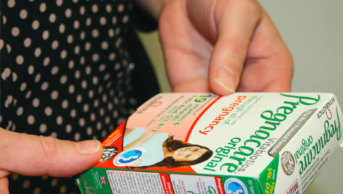
RJSALINAS | DREAMSTIME.COM
This content was published in 2012. We do not recommend that you take any clinical decisions based on this information without first ensuring you have checked the latest guidance.
A. Latanaprost is a prostaglandin analogue available as 50μg/ml eyedrops as Xalatan and, since January 2012, in a range of generic versions. It is licensed for the reduction of elevated intraocular pressure in patients with open angle glaucoma and ocular hypertension. Some products are also licensed for treating elevated intraocular pressure and glaucoma in children.
Latanaprost is one of four topical ocular prostaglandin analogues and prostamides on the UK market, the others being bimatoprost, tafluprost and travoprost. The summaries of product characteristics for all these products include undesirable effects on the eyelashes described as:
- Eyelash and vellus hair changes (increased length, thickness, pigmentation and number); Xalatan
- Growth of eyelashes, eyelash darkening; Lumigan (bimatoprost)
- Changes in eyelashes (increased length, thickness and number of lashes), eyelash discoloration; Saflutan (tafluprost)
- Growth of eyelashes, eyelash discoloration; Travatan (travoprost)
These effects are listed as common (≥ 1/100 to <1/10) or very common (<1/10).
The effect of latanoprost on eyelashes was first described by Johnstone in 1997. He described excessive growth of the eyelashes and hair on the skin just below the eye in which latanoprost was used in 43 patients. He noted differences in hair appearance between the latanoprost-treated eye and the untreated eye, including increased number, length, thickness, curvature and pigmentation. This effect has been noted by other authors, including Demitsu et al, who reported hypertrichosis in 77 per cent of 317 patients using latanoprost.
In a review of the drug’s effect on hair growth Johnstone and Albert wrote “the increased number of visible lashes is consistent with the ability of latanoprost to induce anagen (the growth phase) in telogen (resting) follicles while inducing hypertrophic changes in the involved follicles. The increased length of lashes is consistent with the ability of latanoprost to prolong the anagen phase of the hair cycle. Correlation with laboratory studies suggests that initiation and completion of latanoprost hair growth effects occur very early in anagen and the likely target is the dermal papilla.”
Cosmetic uses
The hypertrichotic effect of latanoprost has been used therapeutically. Mehta et al reported the successful treatment of an 11-year-old girl referred with a history of bilateral loss of eyelashes. She was prescribed latanoprost to be used cutaneously once a day, applied to all eyelids by a dressed orange stick. After 12 weeks of treatment, pronounced lash growth was noted on all four lids. Maintenance of the number of eyelashes was maintained with once weekly treatment.
The use of prostaglandin analogues or prostamides as cosmetic eyelash enhancers is becoming more popular. Allergan advertises its bimatoprost solution Latisse (which, like its original medicinal eyedrop, contains bimatoprost 0.03 per cent) on a website that also advertises botulinum toxin injections and breast implants. Latisse is a prescription-only medicine, granted a licence by the US Food and Drug Administration in 2008. Other eyelash enhancers, such as RevitaLash, MD lash factor and Lilash, contain prostaglandin analogues but are not restricted to supply on prescription.
Safety
Users must carefully assess the potential benefits and side effects of treatment and, with prescription-only medicines, this should be in consultation with a suitably qualified prescriber. Latisse is only licensed in the US. Trials supporting the application for the licence included discontinuations in the active treatment group due to eczema, dry eye, eye inflammation and contact dermatitis.
In Europe the use of topical ocular prostaglandin analogues is restricted to the treatment of glaucoma and ocular hypertension. Potential side effects of latanoprost include eye irritation or pain, increased iris pigmentation, transient punctate epithelial erosions (damage to the corneal epithelium), keratitis, blepharitis, conjunctivitis, blurred vision and, more rarely, intraocular inflammation. In addition, the overgrowth of lashes may result in lash misdirection and distichiasis, an extra row of hair at the aperture of the meibomian glands that can result in eye irritation. Prostaglandin analogues and prostamides can also lead to reactivation of herpes simplex infection, possibly leading to herpetic keratitis, and, less commonly, systemic effects such as headache and dizziness, palpitations, dyspnoea and aggravation of asthma, myalgia and arthralgia.
Further cosmetic effects that users may not find positive are skin rash and darkening of the palpebral skin of the eyelids, which have been reported in the American media. Hypertrichosis of areas other than the intended target, such as the cheek, has also been reported with prostaglandin analogues, as has poliosis (loss of pigment in the hair). All the prostaglandin analogues are contraindicated in pregnant and breastfeeding women.
Some websites, such as eHow, suggest that latanoprost, unlike Latisse which is applied with an applicator to the upper eyelashes only, should be used in the eye: “Application of latanoprost is simple. Just place one drop in each eye once a day in the evenings.” This is likely to give rise to more ocular side effects than cutaneous use and should be strongly discouraged.
Pharmacists should advise that all prescription-only medicines should only be used under medical supervision. This advice is even more applicable when prescription-only medicines are used outside their licensed indications.
Key points
- Topical ocular prostaglandin analogues and prostamides can cause changes in eyelashes by inducing the growth phase in resting follicles and hypertrophic changes.
- Prostaglandin analogue and prostamide products for enhancing eyelashes are available in the US. A medicinal prostamide product licensed in the US for enhancing eyelashes is available in the UK via online supply by medical practitioners. In Europe use of medicinal products containing prostaglandin analogues or prostamides for enhancing eyelashes is outside the product licence.
- Side effects of prostaglandin analogue and prostamide eyedrops include eye irritation, intraocular inflammation as well as overgrowth of eyelashes and pigmentation of the iris and skin.
- Pharmacists should advise that prescriptiononly medicines should only be used under medical supervision.
You might also be interested in…
How to select the right mouthwash

Thalassaemia and iron supplements
